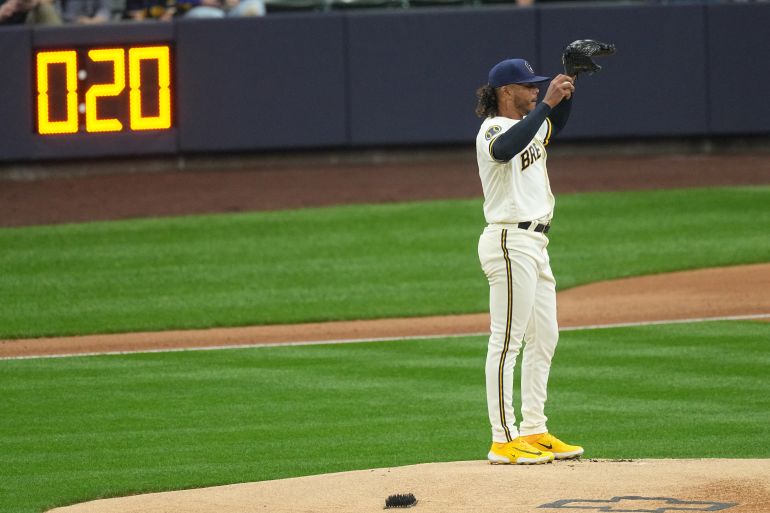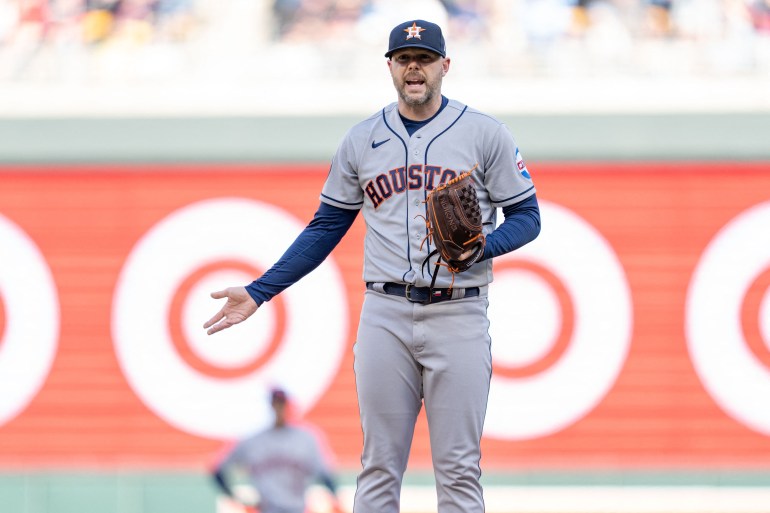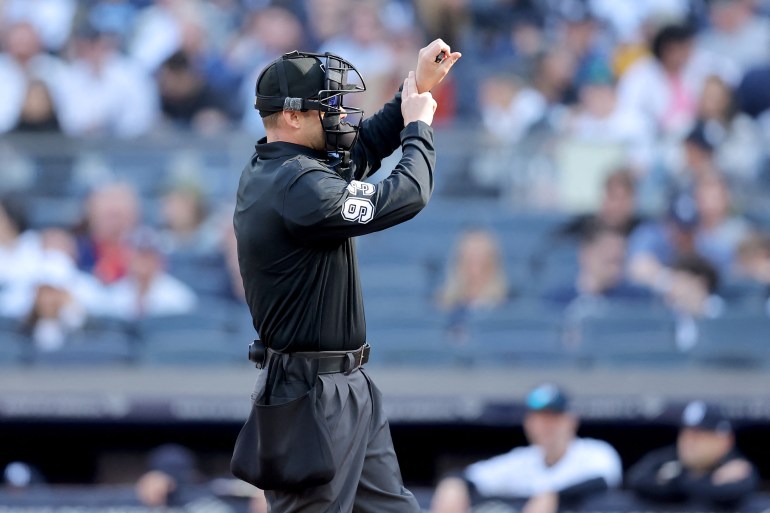MLB seeks ‘best form of baseball’ by picking up the pace
Major League Baseball is using a pitch clock this season, one of a few new rules that experts say are changing the game.

For years, baseball has had to contend with some nagging complaints.
With games regularly stretching past the three-hour mark as drawn-out showdowns between pitchers and batters became the norm, many began to wonder: Was “America’s pastime” becoming too slow, too boring, and too out of touch with what modern fans want?
Keep reading
list of 3 itemsMLB moves All-Star Game in response to voting restrictions
London to host Yankees and Red Sox for first European MLB games
So when Major League Baseball (MLB) announced it was making changes that Commissioner Robert Manfred promised would help “bring back the best form of baseball” this year, US sports expert Randy Roberts said he was not surprised.
“Baseball has a history of changing its rules. The rules have never been written in stone. They didn’t come from Mount Sinai,” said Roberts, a distinguished history professor at Purdue University.
“You’ll always have what are known as the kind of baseball purists who feel that the game should never change,” he told Al Jazeera. “But the game does change and evolve.
“Overall, I think speeding up the game and creating more action are good things.”
New on-field rules are coming in 2023, and we have answers for your questions: https://t.co/Zk1KFZMumG pic.twitter.com/hFyrkagA34
— MLB (@MLB) February 7, 2023
The changes
“Creating more action” in a sport whose roots in the United States date back to the 18th century was the impetus for the series of changes that the MLB introduced for its 2023 season, which officially began at the end of March.
“It is our duty to deliver the best version of the game to our fans,” Manfred said at the end of last season, adding that the league had “boundless optimism” for the future of baseball.
The MLB, composed of 29 teams in the US and one in Canada, has made the bases larger and placed restrictions on how defensive players can be positioned in the in-field (so-called “shift limits”) in an effort to get more balls in play and encourage steals.
The most headline-grabbing difference, though, has been the use of a so-called “pitch clock” to speed up the time between pitches – a system one league executive described as “probably the biggest change that’s been made in baseball in most of our lifetimes”.
MLB pitchers now have 20 seconds to get their pitches off when the offensive team has runners on base and 15 seconds when they do not. Previously, there was no set limit; pitchers could wave off their catcher’s pitch calls – or throw the ball to a base to “check” a runner – as many times as they wanted, extending at-bats.
Now, if a pitch goes over the allowed time, a ball will be awarded to the batter, who also has to follow new, time-related rules at the plate – including the ability to only call one timeout per at-bat.
Manfred told reporters in September that the changes came after extensive research into what baseball audiences hope to see: “Number one, fans want games with better pace. Two, fans want more action, more balls in play. And number three, fans want to see more of the athleticism of our great players.”
Average length of a 9-inning game on #OpeningDay
2022 3:12
2023 2:45— Sportsnet Stats (@SNstats) March 31, 2023
Business of baseball
Tim DeSchriver, associate professor of sport management at the University of Delaware, said the push to make baseball more appealing comes as the game has been “at best holding [its] own, but not growing” in the US like other sports, such as American football, basketball, and football.
The goal, he said, is “to make it a more marketable product”, particularly among younger fans. The league also was hoping to encourage more people to watch games on television, as national and local broadcasting deals make up a large chunk of MLB revenue.
“I definitely think it was not just, ‘We need to make it more entertaining for the fans who are in the seats,’ but also the TV audience,” DeSchriver told Al Jazeera. “There were World Series games ending at 12:30, 1 o’clock in the morning. It’s tough to win over young fans if they’re asleep.”
Other professional sports leagues have implemented rule changes in the past to try to draw in larger audiences, as well.
The National Football League (NFL) has prohibited defensive players from interfering with wide receivers – a rule that encouraged more exciting throws downfield, DeSchriver said, by way of example. And referees in the National Basketball Association (NBA) are quick to call holding fouls, giving the league’s stars a chance to move and score more freely.
“In the last few years, we have seen the number of points scored in the NBA per game go up quite a bit,” he said. “Somebody would rather see a 115-110 game than they would an 80-75 game.”

‘New normal’
But in a sport that is so tightly bound to American culture, changes to baseball have often met resistance and even scorn. Still, most fans appeared to have welcomed the MLB’s changes this season – even despite some early hiccups.
An unforeseen consequence of speedier games has been a drop in beer sales at stadiums, US media outlets reported, pushing some teams to extend sales past their typical seventh-inning cutoff.
And those most affected by the pitch clock – the pitchers themselves – have conceded they are on a learning curve. Some have complained of being winded and rushing pitches to avoid a violation in the first weeks of the season, raising concerns about the potential for injuries.
But most said it was a matter of getting used to the timer.
“I think it’s one of the best things that’s happened to baseball to tweak it, make it a little bit more exciting, make it a little bit faster,” Detroit Tigers manager AJ Hinch told local sports radio station 97.1 The Ticket in early April about the changes.
How much do I love the pitch clock? pic.twitter.com/Fz6FMHmH1k
— Dave Zirin (@EdgeofSports) March 30, 2023
“We’ve got to get a little more athletic to take advantage of the base-stealing component, but count me as a believer in this being good for the game – if we can just get our minds around the fact that it’s our new normal and not the way it used to be,” Hinch said.
This also is not the first time the MLB has adapted the game.
Last year, National League MLB teams were allowed to use designated hitters (DHs) – players who bat in lieu of a pitcher, but do not take the field to play defence – for the first time, decades after the American League first began using DHs. And as of 2020, teams have started each extra inning with a player (the “automatic runner”) on second base in another attempt to speed up the games.
How is the game changing?
According to DeSchriver, it was too early to tell how the new rules were affecting game attendance and TV ratings. “April is always a difficult month for baseball, especially in the more northern cities just due to weather. I think we’ll probably know more by end of May, or sometime in June, on whether is it really having an impact on fan interest,” he told Al Jazeera.
Still, Jeremy Losak, assistant professor in sport analytics at Syracuse University, said while the data remains limited so early into the new season, the changes already appeared to be changing the game itself.
“We’re seeing about an almost 20 percent reduction in dead time between pitches,” he told Al Jazeera, with game times dropping from the more-than-three-hour mark on average to “anywhere between two-and-a-half to three hours”.

A nine-inning MLB game lasted three hours and four minutes on average in 2022, and that has dropped to two hours and 37 minutes so far this season, according to data published by the league on April 21.
Stolen base attempts were up 30 percent, Losak said, while 80 percent of these attempts have been successful – a “drastic” increase of about 40 percent. Walks also have increased, but he said that likely could be attributed in part to pitchers being more rushed with the pitch clock.
“I think there’s going to be a lot more diversity in terms of the type of gameplay that we see. During the 2010s, we saw this massive shift towards the ‘three true-outcome‘ player – players that strikeout, walk, or hit home runs,” Losak said.
“With these rules, there should now be incentive to encourage more singles, and just getting on base, in general.”
That was echoed by Roberts, who said the changes will increase the prospect of singles and inventive defensive and on-base plays – elements of baseball that he said have historically been some of the most exciting.
“I can think of fielding plays that, in some ways, were much more exciting than home runs,” he said, pointing to the centrefield catch Willie Mays made over his shoulder during the 1954 World Series as the “greatest example” of that.
“It’s just an evolution of the game,” Roberts added of the new rules. “And if it’s popular, if it means more people show up, if it creates more action, it will stay.”